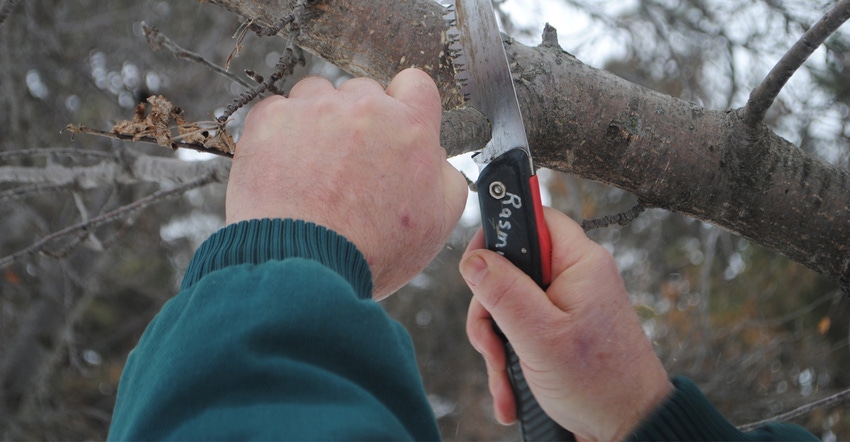
Most farmers like to carry pliers on a holster on their belt. Many farmers claim that pliers are like having an extra hand during challenging tasks. If you lose your pliers, it is like losing a hand. The same could be said of the value of two small hand-held tree tools, including a hand-held pruner and a folding saw.
These tools are irreplaceable when you are cutting wood, clearing brush or doing tree work around the farmstead. That’s why Steve Rasmussen, now-retired Nebraska Forest Service district forester, never heads into the woods without his pruning shear and folding saw in holsters on his belt.
“These are the two tools I probably use the most,” Rasmussen says. We asked Rasmussen to talk about the importance of these the tools, and to give readers more details on their use.
Hand pruners
“There are two styles of hand pruners,” Rasmussen explains. “There is the bypass pruning shear, which I prefer. It acts like a scissors and makes a clean cut.” There is an anvil-style pruning shear, where the blade comes down against the bottom anvil. This is more of a rose pruner, and it works best for dead branches. On live wood, the anvil pruner can leave a ragged edge, which can slow sealing of the wound.
Scissors pruners have a little bit of a curve, so you can reach into the tree to prune branches close to the trunk or larger branches without leaving a stub branch. Hand-held bypass pruners can cost between $20 and $50-plus, depending on quality and the vendor they are purchased from.
Folding saw
The folding hand-held saw works much like the bow saw, but it is more compact, lighter and has more teeth per inch, making for a cleaner cut. And it’s more convenient to handle.
“Because it folds up, it fits into a holster, or you can stick it in your pocket,” Rasmussen says. “That way, it won’t cut your jeans or cause any injuries.” It also has a locking mechanism once it is open, so it locks into place for use.
The folding saw has a couple of nice features. “The blade is somewhat curved, so when I pull, it will pull the teeth of the saw into the wood,” Rasmussen notes. “I really don’t have to put any pressure on the saw. That saves a lot of hand strain if you are doing a lot of pruning.” The handle has a slight hook, allowing you to pull the saw across the branch more easily.
“The blade on these saws is slightly thicker on the bottom than on the top,” Rasmussen explains. “That helps with the cut, because you are cutting a little bit larger as you are cutting down, so the saw doesn’t bind as much on the top.”
Some saws have teeth that are sharpened in three different directions, so that makes for a very sharp saw with a fine cut. The more teeth on the saw per inch, the finer the cut. A typical saw might have seven teeth per inch, so that would easily cut branches up to 2 or 2.5 inches in diameter. Saws with teeth wider apart will more easily cut bigger branches.
“Since you cannot sharpen the blades on these saws, the blades are disposable,” Rasmussen says. “I can usually prune a lot of trees in one season on one blade. I just change out the blade for $10 to $15, and that’s a good investment.”
The folding saw itself can cost between $10 and $30 or more.
About the Author(s)
You May Also Like






